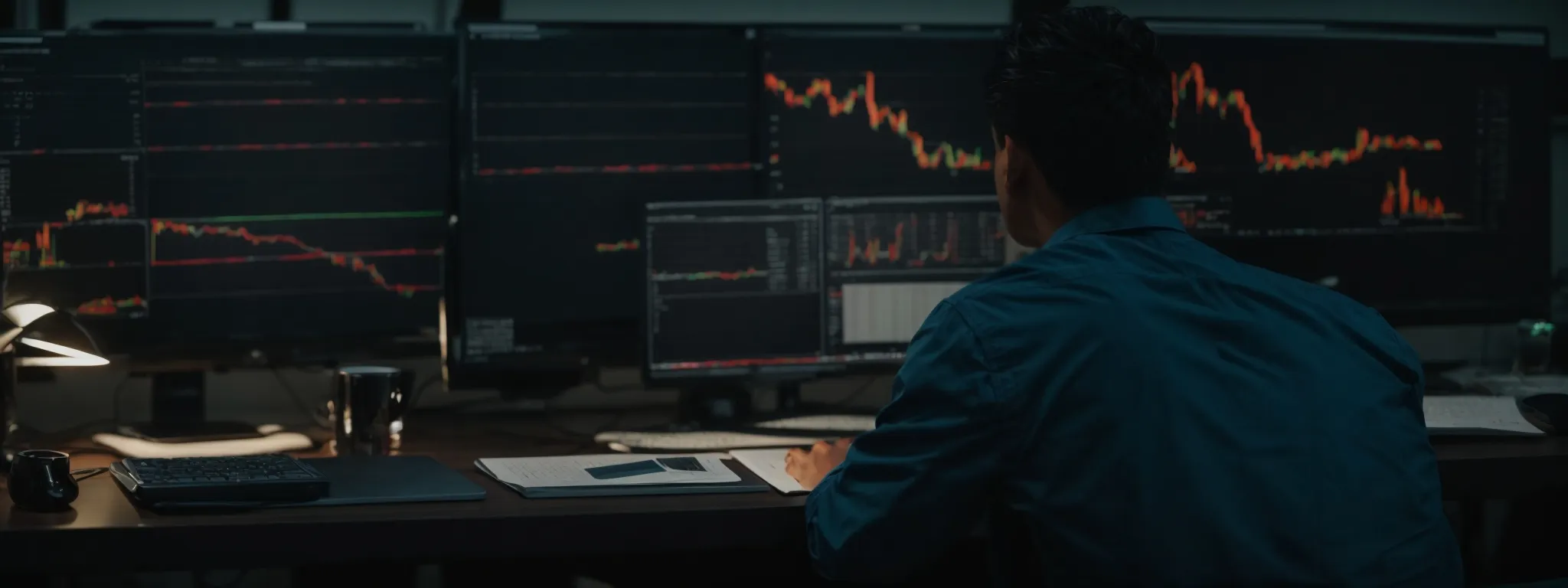The Essence of SEO Indexing
Understanding the Core Principles of SEO Indexing At the heart of SEO lies the critical process of indexing, a pivotal step that determines a website’s visibility to […]
Understanding the Core Principles of SEO Indexing
At the heart of SEO lies the critical process of indexing, a pivotal step that determines a website’s visibility to search engine bots.
This process, intricate by nature, allows search engines to store and organize content, so it can be swiftly presented in response to relevant search queries.
The indexing phase can either catapult a site to the zenith of the Google search results or render it virtually invisible.
LinkGraph’s expertise in enhancing a site’s indexability ensures businesses stake their claim in the digital landscape effectively.
Keep reading to unveil how strategies and solutions like those offered by LinkGraph can optimize your site’s indexing potential for maximum online impact.
Key Takeaways
- Search Engines Use Indexing to Organize Web Content and Provide Relevant Search Results to Users
- Effective Site Structure and Content Quality Are Crucial for Improving a Website’s Indexability
- Technical SEO and on-Page Optimization Are Integral to Ensure Websites Meet Search Engine Standards for Indexing
- Regular SEO Audits and Using Tools Like SearchAtlas SEO Software Can Enhance Indexing Performance and Organic Traffic
- Addressing Common Issues Like Duplicate Content Is Key for Maintaining a Website’s Visibility and Ranking in Search Engine Results
What Is Indexing in SEO?

To truly harness the power of Search Engine Optimization, it is pivotal to begin with a firm grasp on the indexing process, a fundamental concept that forms the bedrock of search functionality.
Amid the plethora of website pages scrambling for visibility, search engines utilize indexing to organize and store content, ensuring that user queries yield the most relevant and valuable results.
By examining the essence of SEO indexing, companies can appreciate its role as the critical underpinning of Effective Search Strategies, setting the stage for a more nuanced exploration of how SEO services like those provided by LinkGraph can optimize this process for better search result positioning.
Defining SEO Indexing in Simple Terms
At its essence, SEO indexing refers to the method by which search engines, such as Google, gather and catalog web pages, allowing them to appear in response to specific searches. This systematic organization of information enables search engines to swiftly retrieve the most pertinent content when a user initiates a search query.
The Indexing Process Begins with the discovery phase, where search engine bots, commonly known as crawlers, traverse the web following links to find new or updated pages to add to the search index:
- Crawlers first visit a website, examining its content and metadata.
- They proceed to follow links on each web page, both internal and external, mapping the architecture of the internet.
- Finally, the search engine analyzes these pages, incorporating them into its vast index, where they become navigable for users through searches.
How Indexing Lays the Foundation for Search
SEO indexing serves as the crux upon which search engines anchor their ability to present relevant information to users. This meticulous process underlines the importance of a Website’s Crawlability, which directly influences its storage in the search engine’s repository and subsequent accessibility to users performing searches.
Through strategic On-Page SEO Services and enhancements in site structure, LinkGraph ensures that a company’s web presence is not only recognized by search engine bots, but also prioritized for indexing, thereby laying a solid foundation for improved visibility in search engine result pages.
The Mechanisms Behind Search Engine Indexing

Delving into the intricate world of SEO indexing requires a concise understanding of the inner workings that search engines employ to organize the digital universe.
Central to this process are two distinct components: The Three Stages of Processing Web Content, which encompass the systematic approach in which content is discovered, analyzed, and stored; and the sophisticated Role of Algorithms in Indexing, a set of complex instructions that determine the prominence and ranking of web pages in search engine result pages.
A clear comprehension of these mechanisms equips businesses with the knowledge to tailor their SEO strategies effectively, and LinkGraph stands at the forefront of this endeavor, providing top-tier services to leverage the fulcrum of indexing to their advantage.
The Three Stages of Processing Web Content
The quest for online visibility commences with the cornerstone practice of SEO indexing, where a trio of phases – crawling, processing, and storing – plays a critical role. Search engines deploy bots to scour the internet, meticulously inspecting and noting each new or modified web page encountered:
| Phase | Description | Significance |
|---|---|---|
| Crawling | Search engine bots navigate through a network of URLs to identify content. | Initiates the indexing process and uncovers web page existence. |
| Processing | Algorithms evaluate content relevance and determine page quality. | Refines the content pool to match user queries with precision. |
| Storing | Qualified content is indexed and organized within the search engine’s database. | Enables swift content retrieval for relevant search queries. |
Subsequent to discovery, search engines analyze each page’s relevance and usefulness: pages resplendent with valuable information ascend within this digital hierarchy. LinkGraph harnesses this knowledge, offering on-page SEO services that align with search engines’ propensity to favor content that not only exists but excels, propelling clients toward the summit of search engine result pages.
Understanding the Role of Algorithms in Indexing
Algorithms are the unsung architects of the indexing process, pivotal to structuring the vast repository of search engine data. In their sophisticated dance, these algorithms scrutinize web pages for signals such as keyword density, site structure, and user engagement to prioritize and rank content within the search index.
LinkGraph’s adept utilization of search engine algorithms allows clients to navigate this complex environment, ensuring their web pages are optimized to meet the exacting standards set forth by search engines. This meticulous alignment with algorithmic preferences is critical for businesses aiming to secure a coveted spot in the upper echelons of search engine result pages.
Factors That Influence SEO Indexing

Mastering the intricacies of SEO indexing demands a nuanced understanding of the multifaceted elements that engines evaluate.
Two critical factors stand out in their influence over a website’s indexability: the caliber of the content itself and the architecture of the site hosting it.
Evaluating content quality for indexability is paramount; search engines favor content that offers depth, relevance, and value to users.
Concurrently, the impact of site structure on indexing cannot be understated, as it dictates the ease with which search engines can navigate and catalogue a site’s offerings.
LinkGraph excels in enhancing these pivotal aspects, ensuring that businesses not only meet but exceed the rigorous standards search engines hold for inclusion in their indices.
Evaluating Content Quality for Indexability
The crucible of content assessment for indexability by search engines comprises a thorough investigation into the elements of quality and utility. Search engines consistently prioritize content that provides comprehensive insight, directly responds to user intents, and demonstrates substantial expertise.
A website’s content must not only inform but also engage, persuading search engines of its worthiness for indexing. The pursuit lies in delivering material that balances keyword relevance with reader resonance, fostering both a searchable and satisfying user experience.
| Content Aspect | Criteria for Evaluation | Impact on Indexability |
|---|---|---|
| Relevance | Alignment with user search intent and query specifics | Increases the likelihood of being deemed a valuable resource |
| Expertise | Evidence of depth, accuracy, and authoritative information | Enhances content credence and indexation prospects |
| Engagement | Capability to captivate and retain user interest | Signals content quality, favoring index inclusion |
The Impact of Site Structure on Indexing
Site structure holds significant sway over indexing, serving as a roadmap that guides search engine bots through a website’s content maze. A well-organized site structure promotes thorough crawling and ensures that no page of value goes unnoticed or unindexed.
Search engines favor architectures that facilitate seamless navigation, allowing their algorithms to intuitively understand hierarchy and content relevance within a site. When assessing site design, consider these key elements to improve indexability:
- Logical URL structure for clear content categorization.
- Internal linking strategies that weave a cohesive content network.
- A well-crafted sitemap that outlines the site’s structure succinctly to search engines.
Strategies to Enhance Your Site’s Indexability

Discerning the intricacies of search engine indexing unveils a path to enhanced visibility and organic traffic for businesses.
Two proven methods stand at the helm of this pursuit: the implementation of technical SEO principles and the meticulous application of On-Page Optimization Techniques.
These strategies are pivotal for not only abiding by the methodologies search engines rely upon but for asserting the pertinence and accessibilty of content to the algorithms that govern the digital landscape.
In this pursuit of optimizing indexability, LinkGraph’s suite of SEO services emerges as a beacon, steering clients through the complexities of website optimization for exemplary indexing outcomes.
Utilizing Technical SEO for Stronger Indexing
Within the labyrinth of technical SEO, adept mastery of elements such as Meta Tags, robot exclusion protocols, and site load speed can vastly improve a site’s indexability. LinkGraph applies precision and expertise when optimizing these technical facets, ensuring that clients’ websites comply with the protocols that search engine bots prioritize when indexing.
The optimization of technical aspects extends beyond mere compliance, venturing into the realm of strategic advantage. Particularly, LinkGraph’s approach to enhancing crawlability and ensuring swift page responses positions clients’ websites for expedited discovery and optimal indexing by search engines:
- Implementing responsive design to favor mobile-first indexing.
- Refining website infrastructure to optimize crawl budget utilization.
- Executing comprehensive audits to identify and resolve indexing obstacles.
Employing on-Page Optimization Techniques
On-page optimization techniques are a linchpin in securing a website’s indexability, where every element on the web page is scrutinized and fine-tuned to meet search engine standards. LinkGraph elevates on-page content through strategic keyword placement and high-quality, informative material, ensuring resonance with both users and search algorithms.
LinkGraph meticulously leverages the potency of meta tags, crafting descriptions that beckon to search engine bots and accurately reflect the page’s content. This precise approach harmonizes with the meticulous requirements of search engines, facilitating enhanced content discovery and indexing.
Common Indexing Problems and How to Resolve Them

Navigating the realm of search engine optimization encompasses confronting the myriad of challenges that impede a brand’s potential to appear prominently within search results.
Among these challenges, issues with indexation stand as common yet significant hurdles that, if not addressed, can obscure valuable content from reaching its intended audience.
Identifying and rectifying such impediments is essential for maintaining a robust online presence, especially when contending with duplicate content or harnessing webmaster tools to troubleshoot indexation mishaps.
LinkGraph’s expertise plays a pivotal role in diagnosing these common indexing concerns, thereby ensuring that businesses effectively resolve them, optimizing their content for better search engine visibility and performance.
Troubleshooting Indexation Issues With Webmaster Tools
Webmaster tools serve as valuable instruments for unraveling the enigmas of SEO indexing issues. They equip website owners with precise diagnostics and actionable insights into how search engine bots perceive and interact with their web content, allowing for the identification and rectification of any indexing discrepancies.
LinkGraph’s expertise facilitates the adept use of these tools, ensuring that any hindrances such as crawl errors or misconfigured directives are promptly addressed. This proactive stance not only restores content visibility but also reinstates a website’s standing within the digital search landscape.
Avoiding and Fixing Duplicate Content for Better Indexing
Duplicate content poses a conundrum in SEO indexing as it can cause search engines to become confused about which version to prioritize, often leading to dilution in page authority and ranking. LinkGraph’s SEO experts tackle this challenge head-on, implementing canonical tags and adjusting content to convey clear, unique signals to search engines, thus safeguarding against the pitfalls of redundancy.
To remediate the issues associated with duplicate content, LinkGraph’s meticulous approach includes a thorough audit to identify problematic duplications and strategic reconfiguration of website structure. This careful attention ensures that each piece of content is indexed singularly, boosting the site’s overall SEO efficacy and improving its visibility in search engine result pages.
Monitoring Your Indexing Status for Continued SEO Success

Maintaining adept awareness of your website’s indexing status is an essential aspect of Search Engine Optimization and a continual process that demands vigilance.
Tracking and enhancing your website’s indexing performance is instrumental in ensuring that your content remains visible and competitively ranked within search engines.
This endeavor is fortified by leveraging specialized tools designed for indexing performance measurement, and through the application of Periodic SEO Audits.
These practices equip businesses with necessary insights and opportunities for optimization, effectively fortifying their SEO success over time.
Tools for Tracking Your SEO Indexing Performance
Effective tracking of SEO indexing performance is integral to maintaining a robust online footprint, and tools like SearchAtlas SEO software serve as critical resources in this endeavor. These tools provide real-time insights into index status, revealing the SEO strengths and potential vulnerabilities of a website’s content as perceived by search engines.
LinkGraph’s SearchAtlas SEO software stands out by offering Comprehensive Reporting Metrics that enable businesses to assess their organic traffic and gauge their prominence in search engine result pages. By utilizing these advanced tools, businesses can adapt strategies and align efforts with the evolutionary patterns of SEO, fostering sustained digital growth.
Continuously Improving Your Indexing With SEO Audits
Engaging in regular SEO audits offers a pivotal opportunity for businesses to clarify the impact of their content within the search index. LinkGraph delivers this critical service, meticulously dissecting each aspect of a client’s website, identifying areas ripe for advancement, and executing targeted improvements that amplify indexability and search presence.
Through these comprehensive audits, LinkGraph uncovers nuanced insights, paving the way for informed adjustments that bridge any gaps in SEO performance. Their expertise ensures Continuous Refinement of a website’s indexing status, reinforcing its authority and maintaining its competitive edge in the dynamic landscape of search engine results.
Conclusion
Understanding the core principles of SEO indexing is paramount for businesses seeking to elevate their online visibility and search engine rankings.
SEO indexing lays the groundwork for how search engines discover, process, and store web content, making it accessible to users.
Companies like LinkGraph capitalize on this understanding to enhance websites’ crawlability and align them with search engines’ indexing algorithms.
They achieve this through meticulous on-page optimizations and technical SEO tactics, addressing any potential indexing issues such as duplicate content.
Regularly tracking and auditing indexing performance is crucial for maintaining and improving a site’s SEO standing.
Ultimately, a comprehensive grasp of SEO indexing’s fundamentals enables businesses to fine-tune their strategies effectively and consistently, ensuring their content remains discoverable and relevant in the ever-evolving digital landscape.














































































